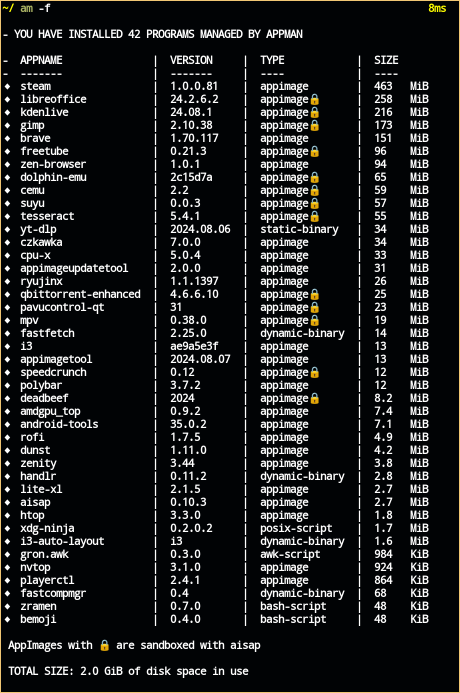Hi all,
I am about to do a bit of a distro hop, and I am looking at Fedora and its spins, after years on Debian / POP.
I am not looking forward to setting it all up again, it’s a drag.
I wonder, is there a tool that lets me script installs?
I’ll want to check if application exists, and if so, update, otherwise, install. That kind of thing.
Things like:
- Telegram
- Joplin
- Docker
- Firefox
- Ungoogle Chromium
- Sublime Text
- VSCodium
- Keepass
- Thunderbird
- DBeaver
- Gimp
- Inkscape
- KDENLive
- Syncthing
- Steam
- VLC
- Localsend
- Flameshot
- Element
- Cherrytree
- Calibre
- Anydesk
I show the list, only to give an idea of what might be involved.
I’m new to Fedora, so not sure how it differs beyond the package manager. But, thought I’d ask.
Does such a tool exist, and is it worth my time? I can practice on a VM before trying on the final install/s.
Thank you
Using ansible will help you on your 2nd, 3rd , nth install.
But getting ansible to do what you want (plus testing) for the first time would takes 10x longer than manual install.
I think there’s xkcd about that.
Just installing applications is pretty easy though.
--- - hosts: localhost become: yes tasks: - name: Install required software dnf: state: latest name: - firefox - telegram - calibreansible-playbook install.ymlSomething like that (untested)
I distinctly remember yum/dnf should be using a loop. Forget why but it’s recommended. Here’s a snippet from my playbook. Simply make the vars as you need and run.
- name: Install flathub as remote ansible.builtin.shell: cmd: flatpak remote-add --if-not-exists flathub https://dl.flathub.org/repo/flathub.flatpakrepo tags: - apps - name: Install flatpak apps community.general.flatpak: name: "{{ item }}" state: present loop: "{{ flatpaks }}" tags: - apps - name: Remove some default unused packages ansible.builtin.dnf: name: "{{ item }}" state: absent update_cache: no loop: "{{ remove }}" ignore_errors: true tags: - apps - name: Install our packages ansible.builtin.dnf: name: "{{ item }}" state: present update_cache: yes loop: "{{ rpms }}" ignore_errors: true tags: - apps``` On mobile. Apologies if formatting is off.
You could write yourself a bash script to do this.
This ended up working perfectly
Awesome!
I have a bash script I use to script my Silverblue install. Something like this should work.
# space-separated list of packages to install S_RPM_PACKAGES_TO_INSTALL="pkg1 pkg2 pkg3" # function to install the packages dnf_install () { sudo dnf install -y $1 } # call to function, passing the list dnf_install "$S_RPM_PACKAGES_TO_INSTALL"I have it set up this way so that I just have a bunch of bash variables describing the stuff I want to install all at the top of the file, but the function definitions and calls lower down since I don’t need to see them.
It also does other things like removes packages from the system, removes some preinstalled flatpaks, installs flatpaks from Fedora Flatpaks / Flathub / gnome-nightly, and sets up gnome through a list
gsettingscommands.As I use my system, I add new apps to the list I want next time I install and remove apps I don’t use.
I love this, I will update the script I’ve setup to mirror your idea. Nice and clean.
I wonder if you can help at all? The only app that fails install is Anydesk. I have to do the following:
# Anydesk sudo tee /etc/yum.repos.d/anydesk.repo<<EOF [anydesk] name=AnyDesk Fedora Linux baseurl=http://rpm.anydesk.com/fedora/x86_64/ gpgcheck=1 repo_gpgcheck=1 gpgkey=https://keys.anydesk.com/repos/RPM-GPG-KEY EOFsudo dnf install anydesk -yBut it gives an error, saying :
[anydesk] name=AnyDesk Fedora Linux baseurl=http://rpm.anydesk.com/fedora/x86_64/ gpgcheck=1 repo_gpgcheck=1 gpgkey=https://keys.anydesk.com/repos/RPM-GPG-KEY AnyDesk Fedora Linux 397 B/s | 488 B 00:01 AnyDesk Fedora Linux 1.8 kB/s | 1.7 kB 00:00 Importing GPG key 0xCDFFDE29: Userid : "philandro Software GmbH <info@philandro.com>" Fingerprint: D563 11E5 FF3B 6F39 D5A1 6ABE 18DF 3741 CDFF DE29 From : https://keys.anydesk.com/repos/RPM-GPG-KEY AnyDesk Fedora Linux 796 B/s | 1.2 kB 00:01 Error: Problem: conflicting requests - nothing provides libgtkglext-x11-1_0-0 needed by anydesk-6.3.2-1.x86_64 from anydesk (try to add '--skip-broken' to skip uninstallable packages)Is there a special way to add that kind of command to a bash script? All good apart from that though.
I think that’s just a dependency issue unrelated to the script.
ok, thank you. I’ll address that, in that case. Thanks again!
EDIT, and resolved. Thanks again.
I did more than 5 installs this weekend (for … reasons) and the “trick” IMHO is …
Do NOT install things ahead of actually needing them. (of course this assume things take minutes to install and thus you will have connectivity)
For me it meant Firefox was top of the list, VLC or Steam (thus NVIDIA driver) second, vim as I had to edit crontab, etc.
Quite a few are important to me but NOT urgent, e.g Cura (for 3D printer) and OpenSCAD (for parametric design) or Blender. So I didn’t event install them yet.
So IMHO as other suggested docker/docker-compose but only for backend.
Now… if you really want a reproducible desktop install : NixOS. You declare your setup rather than
apt install -yand “hope” it will work out. Honestly I was tempted but as install a fresh Debian takes me 1h and I do it maybe once a year, at most, no need for me (yet).Another “trick” I use is having an ~/Apps directory in which I have AppImage, binaries, etc that I can bring from an old /home to a new one. It’s not ideal, bypassing the package manager, and makes quite a few assumption, first architecture, but in practice, it works.
Check this out: https://github.com/ivan-hc/AM
Use
appmanand set the install directory to~/Appsand now you will be able to install appimages/binaries in the ~/Apps dir using a package manager that keeps them up to date and that you can move to any other distro, I have all of this:
Although more recently for binaries I’ve been using this instead, which pulls from a massive repo of static binaries, though note that dbin needs its own separate directory in HOME to install binaries (you can’t use ~/Apps that is).

Hmmm very interesting thanks for the links and explanation!
I’m not “ready” for it yet so I’ve bookmarked all that (by adding a file in ~/Apps ;) but that’s definitely and interesting, and arguably neater solution.
Honestly I try to stick to the distribution package manager as much as I can (apt on Debian stable) but sometimes it’s impossible. Getting binaries myself feels a bit “wrong” but usually works. Some, like yt-dlp as I see in your list, do have their own update mechanisms. Interesting to consider stepping back and consider the trade off. Anyway now thanks to you I know there are solutions for a middle ground!
Also this is a good way to re-consider integration back, e.g. generating .desktop files for
/.local/share/applications/when using KDE rather than having to manually do it each time.This is already done automatically.
AM puts the .desktop files in
/usr/local/share/applicationsAppMan puts them in
${XDG_DATA_HOME:-~/.local/share}applicationsThey also get symlinked in PATH, that is you can launch yt-dlp by typing
yt-dlpon the terminal as if you had installed it with your distro package manager.Ah! Wonderful. I’m always a bit reluctant with system-wide install so I’ll put AM on hold for now but probably tinker with AppMan/dbin soon.
Out of curiosity, one of the app I’d usually get outside my package manager is Chromium. I’d usually download the latest build from https://download-chromium.appspot.com/ so in this situation, how would you do it using any of those solutions? Would it support adding extensions e.g https://chrome.google.com/webstore/detail/immersive-web-emulator/cgffilbpcibhmcfbgggfhfolhkfbhmik that I need for development?
PS: note to self, go through bash history to see which failed
apt installattempts could be replaced with such tools.
It pulls the latest chromium from googleapis.com so it can do everything.
Something like Ansible won’t help you the first time around, but it’ll make the next times easier.
It can make the first time around easy if you use the proper plugin
Could you just build a base image and then deploy it?
Also Ansible is pretty solid
I use yadm’s post-checkout script feature to accomplish this on my machines.
Or any of the similar tools listed here, based on personal preferences! I currently use Chezmoi, but I like that they help you discover alternatives.
Have you tried SaveDesktop? Thought It is limited in the flatpak softwares, but cloud synchronization feature is recently added.
Was looking for this in this comment section, I see this solution as becoming the goto for moving between installs even though it is limited right now
That’s one of the things I miss the most in Gentoo, having the packages of your system defined in text files so a fresh install was just copying those files and running an update.
I’ve tried similar things with other distros, but it’s never the same, the list of packages ends up getting out of date or ends up with too much garbage.
Currently I have a home server so I took the time to get an Ansible playbook setup for running, maintaining, and maybe migrating the server if needed. Since some stuff is also run on other machines that I have (update system, update some docker images I run in multiple systems, etc) I did setup some minimal packages that I need on my main system, it’s easy enough but I wouldn’t recommend using Ansible just for this (but if you also have dotfiles it’s a great tool for automating lots of the initial setup).
All of that being said, the reason I never bothered with this until I had a home server is that usually there are years between system installs, so even if what you had was exactly what you wanted the last time you installed your system, it’s unlikely to be exactly what you want next time you do. Since the last time I installed my main system I switched from X to Wayland, from i3 to Hyprland and then Sway, etc, etc…
I use an Ansible playbook to do fresh install stuff such as app installs & joining my local Samba AD.
Another option, that I’ve never tried, would be to put your /home directory on another partition. That only solves the settings though and not your app installation bit.
Do you use Windows?
I daily drive Debian and use Windows for work. Only have one Windows VM for playing games via Moonlight.
So you use Samba AD for the Windows VM?
Correct. I’m running two AD DC’s based on Samba, all running on Zentyal. Super simple to install & setup. I them run a VM in Virtualbox on my laptop for the rare occasions I need to use the Windows RSAT tools.
Other than that, all my Linux VM’s, ProxMox hosts & unRAID NAS all set to auth against the Samba DC. It has been working perfectly for over a year now.
I don’t believe Zentyal is supported by the Samba team. I’d just stick to regular Samba DCs.
I am personally debating on setting up either Samba AD or FreeIPA. FreeIPA is definitely better for Linux but I really like Samba. Thanks for answering my question.
I do use docker, and compose a lot. But can it be used for desktop apps? Telegram, gimp, Thunderbird, etc?
It should be possible. Although probably very complicated. Have a look at https://distrobox.it/. It allows you to tightly integrate containers into your desktop, including accelerated graphics, some devices, your homedir, etc. It can even automatically install desktop shortcuts. (You can disable the integrations of course) Even tho it uses Podman instead of docker, AFAIK it should be 1:1 compatible with docker for your usecase.
Have a look at https://distrobox.it/. It allows you to tightly integrate containers into your desktop, including accelerated graphics, some devices, your homedir, etc. It can even automatically install desktop shortcuts. (You can disable the integrations of course)
Furthermore, distrobox allows you to define the list of packages to be installed, see:
https://github.com/89luca89/distrobox/blob/main/docs/usage/distrobox-assemble.md
That is very cool. Thanks for sharing. If you need some additional repos (like OP), you can probably add them through some commands in the “pre_init_hooks” option.
Some distros allow this. Nix for example allows you to save config files that describe your entire system (apps, settings, etc) and then load them in one go. Other distros are following suit with their own tailored solutions too (I think Ubuntu might have something? Manjaro?).
You can even have all nixpkgs on a different distro through the nix package manager
deleted by creator
I wonder, is there a tool that lets me script installs?
I’ll want to check if application exists, and if so, update, otherwise, install. That kind of thing.
Use AppMan to install them in HOME.
Nix and home-manager, those are the only 2 I have off the top of my head.






